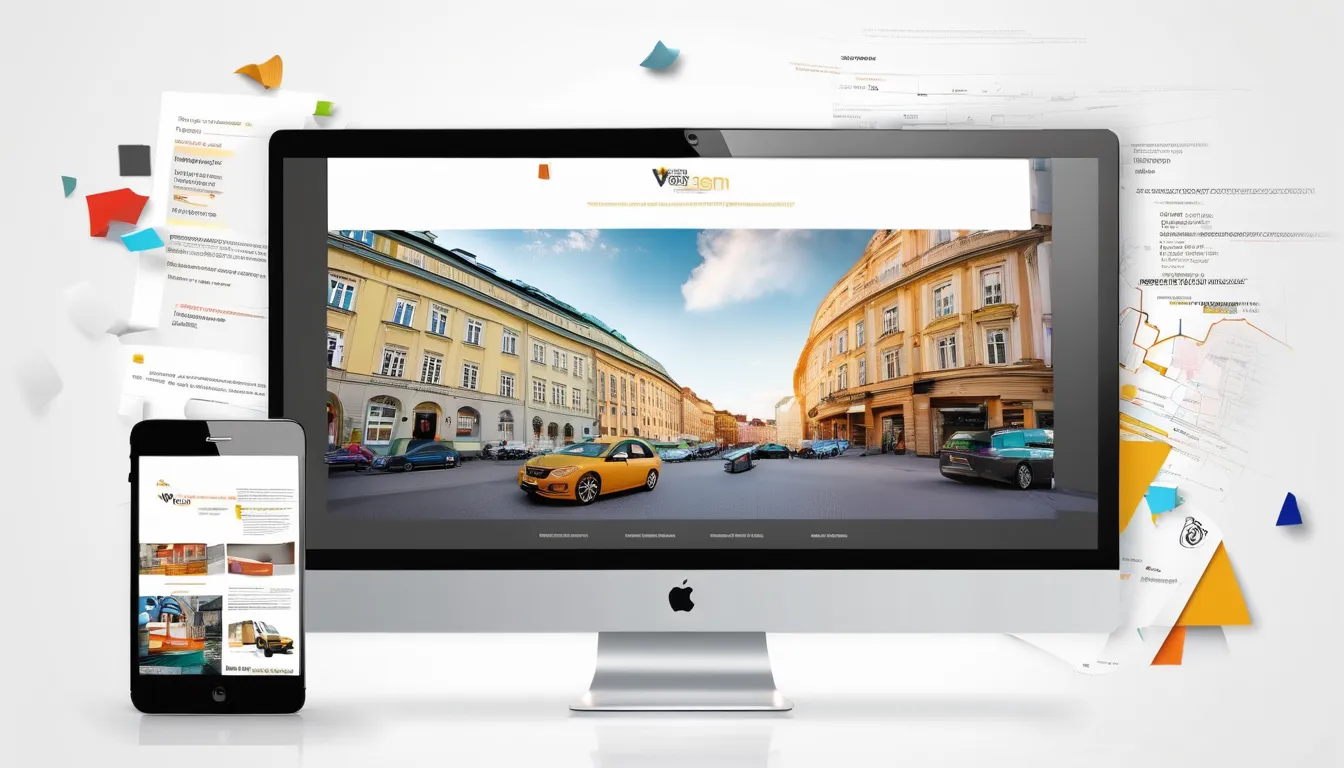When you’re designing a website, understanding user experience (UX) is crucial for creating engaging interfaces that resonate with your audience. You might think about how factors like usability, accessibility, and visual hierarchy play into the overall effectiveness of your site. By employing strategies such as wireframing and usability testing, you can refine your approach and cater to diverse user needs. But what happens when you overlook these elements? The answer could significantly impact your site’s success and user loyalty, prompting a closer look at the essential principles of UX design.
Understanding User Experience
When it comes to web design, understanding user experience is crucial for creating a site that truly resonates with your audience. User experience (UX) refers to how users interact with and feel about your website. It encompasses everything from the layout and navigation to the content and functionality.
To start grasping UX, you need to put yourself in your users’ shoes. Think about their needs, goals, and challenges. What’re they looking for? What problems are they trying to solve?
You should also consider the emotional response your design elicits. Does it make users feel welcomed and engaged, or frustrated and confused?
Use tools like user personas and journey mapping to visualize their experience. These tools can help you identify pain points and areas for improvement.
Importance of UX in Web Design
The impact of user experience (UX) on web design can’t be overstated; it directly influences how visitors perceive and interact with your site. A well-designed UX keeps users engaged, encourages them to explore more, and enhances their overall satisfaction. When you prioritize UX, you’re not just creating a website; you’re crafting a seamless journey that resonates with your audience.
When visitors find your site easy to navigate, they’re more likely to stay longer and return in the future. Conversely, a confusing layout or slow-loading pages can frustrate users, leading to high bounce rates. You want to foster a positive impression right from the first click, which can significantly affect your brand’s credibility.
Moreover, effective UX design can boost conversions. By simplifying the purchasing process or making information easily accessible, you guide users toward taking desired actions. It’s essential to recognize that your website serves as a digital storefront; a poor UX can deter potential customers.
Ultimately, investing in UX design not only enhances user satisfaction but also contributes to your site’s success. Prioritizing UX is a strategic move that can lead to increased engagement, loyalty, and profitability.
Key Principles of UX Design
Effective UX design hinges on several key principles that guide the creation of user-centered websites.
First, prioritize usability. Make sure your site is easy to navigate, with intuitive menus and clear labels. Users should find what they need without unnecessary effort.
Next, focus on accessibility. Design your website to be inclusive for all users, including those with disabilities. Use appropriate contrast, alt text for images, and ensure your site is navigable via keyboard.
Another principle is consistency. Establish a uniform design language throughout your site, including colors, fonts, and button styles. This helps users feel familiar and comfortable as they explore.
Don’t forget about feedback. Provide clear responses to user actions, like confirming a successful form submission or indicating loading times. This keeps users informed and engaged.
Lastly, embrace simplicity. Avoid clutter and distractions. A clean, straightforward design allows users to focus on essential content and tasks without feeling overwhelmed.
User Research Techniques
To create a successful user experience, understanding your audience is crucial, and that’s where user research techniques come into play. Start by conducting interviews with potential users. This helps you gather qualitative insights about their preferences and pain points.
You can also use surveys to collect quantitative data from a larger audience, giving you a broader perspective on user needs.
Another effective technique is usability testing. By observing users as they interact with your site or product, you can identify areas for improvement.
Don’t forget about creating user personas, which represent your target audience. These personas help you keep user needs front and center during the design process.
Additionally, consider employing A/B testing to compare different design elements. It allows you to see which version resonates better with your users.
Analyzing user analytics can also provide valuable insights into user behavior, showing you where they engage or drop off.
Wireframing and Prototyping
Starting with wireframing and prototyping can significantly streamline your web design process. These essential steps allow you to visualize your ideas and structure your site before diving into the actual design.
Wireframes are basic sketches of your layout, showcasing elements like navigation, content areas, and buttons. They help you focus on functionality and user flow without getting distracted by colors or graphics.
Once you’ve solidified your wireframe, it’s time to create a prototype. Prototypes are more interactive and give you a better feel for the user experience. You can test navigation, interactions, and overall usability. By simulating real user interactions, you’ll identify potential issues early on, saving time and resources later.
Additionally, sharing your wireframes and prototypes with stakeholders or users can gather valuable feedback. This collaborative approach ensures everyone’s on the same page and can lead to a more refined final product.
Designing for Accessibility
After laying the groundwork with wireframing and prototyping, it’s important to consider how your design accommodates all users. Designing for accessibility ensures that everyone, including those with disabilities, can navigate and interact with your site effectively. By incorporating accessible features, you create an inclusive experience that enhances usability for all.
Start by implementing keyboard navigation, allowing users to browse without a mouse. Use clear, simple language and provide alternative text Webdesign Firma Wien images, ensuring visually impaired users understand your content. Consider color contrast; choose combinations that make text easy to read for individuals with color blindness.
Here’s a quick reference table for essential accessibility features:
| Feature | Description |
|---|---|
| Keyboard Navigation | Enables use of the site without a mouse |
| Alt Text for Images | Describes images for screen readers |
| Color Contrast | Ensures readability for all users |
| Clear Language | Avoids jargon, making content simple |
| Responsive Design | Adapts to different devices |
Visual Hierarchy in Interfaces
Visual hierarchy plays a crucial role in guiding users through your interface effectively.
By using techniques like size, color, and placement, you can draw attention to the most important elements and improve overall usability.
Let’s explore how mastering visual hierarchy can enhance your design and user experience.
Importance of Visual Hierarchy
In the fast-paced world of web design, understanding the importance of visual hierarchy can make or break a user’s experience. When you create a well-structured visual hierarchy, you’re guiding users through your content seamlessly. This means they can quickly identify key information without feeling overwhelmed.
Visual hierarchy helps prioritize elements on your page, making it easier for users to focus on what’s most important. For instance, larger fonts, bold colors, or strategic placements draw attention to headlines and calls to action. By effectively using these techniques, you can lead users toward desired actions, whether that’s signing up for a newsletter or making a purchase.
Moreover, a clear visual hierarchy improves accessibility. Users with varying levels of experience or those using assistive technologies benefit from a well-organized layout, as it allows them to navigate your site more intuitively. You’ll reduce cognitive load, allowing users to absorb information more efficiently.
Ultimately, neglecting visual hierarchy can frustrate users, causing them to leave your site in search of a better experience. By prioritizing this aspect of design, you create a more engaging and user-friendly interface that keeps visitors coming back.
Techniques for Effective Design
Creating an effective design involves implementing specific techniques that enhance visual hierarchy in your interfaces. By focusing on how users perceive information, you can guide their attention to the most important elements. Here are three techniques to consider:
- Size and Scale: Use size to your advantage. Larger elements naturally draw more attention, so make crucial buttons or headings bigger. This helps users quickly identify key actions or information.
- Color Contrast: Utilize contrasting colors to highlight important features. For instance, a bright call-to-action button against a muted background will stand out and encourage clicks, making it clear what users should focus on.
- Whitespace: Don’t underestimate the power of whitespace. By strategically placing space around elements, you create a clean interface that allows users to breathe and easily navigate. It helps separate content and emphasizes what matters most.
Implementing these techniques won’t only improve the visual hierarchy of your design but also enhance user experience, leading to more engaging and intuitive interfaces.
Mobile Responsiveness
Ensuring your website is mobile responsive is crucial in today’s digital landscape. With a significant number of users accessing the internet via smartphones and tablets, your site must adapt seamlessly to various screen sizes. If it doesn’t, you risk losing potential visitors and customers.
To achieve mobile responsiveness, start by employing a responsive design framework. This allows your layout to adjust fluidly based on the device’s screen dimensions. Use flexible images and CSS media queries to ensure that all elements display correctly on different devices.
Test your site across various mobile devices and browsers to identify any issues that might arise.
Don’t forget about touch interactions. Make sure buttons and links are easy to tap and that forms are user-friendly on smaller screens. Consider how your content flows; prioritize essential information so users don’t have to scroll endlessly.
Lastly, keep your loading times in check. A slow-loading site can frustrate users and lead them to abandon your page.
Usability Testing Methods
Evaluating your website’s usability is essential for creating an optimal user experience. It helps you identify issues that may frustrate users and keep them from engaging with your content.
Here are three effective usability testing methods you can use:
- A/B Testing: This method involves creating two versions of a webpage and comparing their performance. You can analyze which design, layout, or content resonates better with your audience by measuring key metrics like click-through rates and conversion rates.
- User Interviews: Conducting one-on-one interviews with users allows you to gather qualitative data about their experiences. Ask them about their frustrations, what they find intuitive, and any suggestions for improvement. This direct feedback can be invaluable.
- Remote Usability Testing: Utilize online tools to observe users interacting with your site from anywhere. This method provides insights into how real users navigate your site, uncovering any usability issues they encounter in their natural environment.
Continuous Improvement Strategies
Embracing a mindset of continuous improvement can significantly enhance your website’s user experience. Start by regularly gathering user feedback through surveys, interviews, or usability testing. This provides you with valuable insights into what works and what doesn’t.
Pay attention to patterns in user behavior, and don’t hesitate to make changes based on this data.
Next, implement A/B testing to compare different design elements or functionalities. This helps you understand which options resonate better with your audience. Once you identify successful strategies, integrate them into your design and continuously monitor their performance.
Additionally, keep an eye on industry trends. Web design is always evolving, and staying updated ensures your site remains relevant.
Regularly review analytics to identify drop-off points or pages that need improvement.
Conclusion
In conclusion, focusing on user experience in web design is essential for creating engaging interfaces that meet your audience’s needs. By understanding UX principles, conducting thorough user research, and implementing effective design techniques like wireframing and usability testing, you’ll enhance usability and satisfaction. Remember, continuous improvement through feedback is key to keeping your website relevant and effective. Prioritizing UX not only boosts conversions but also fosters long-term loyalty among your users.



